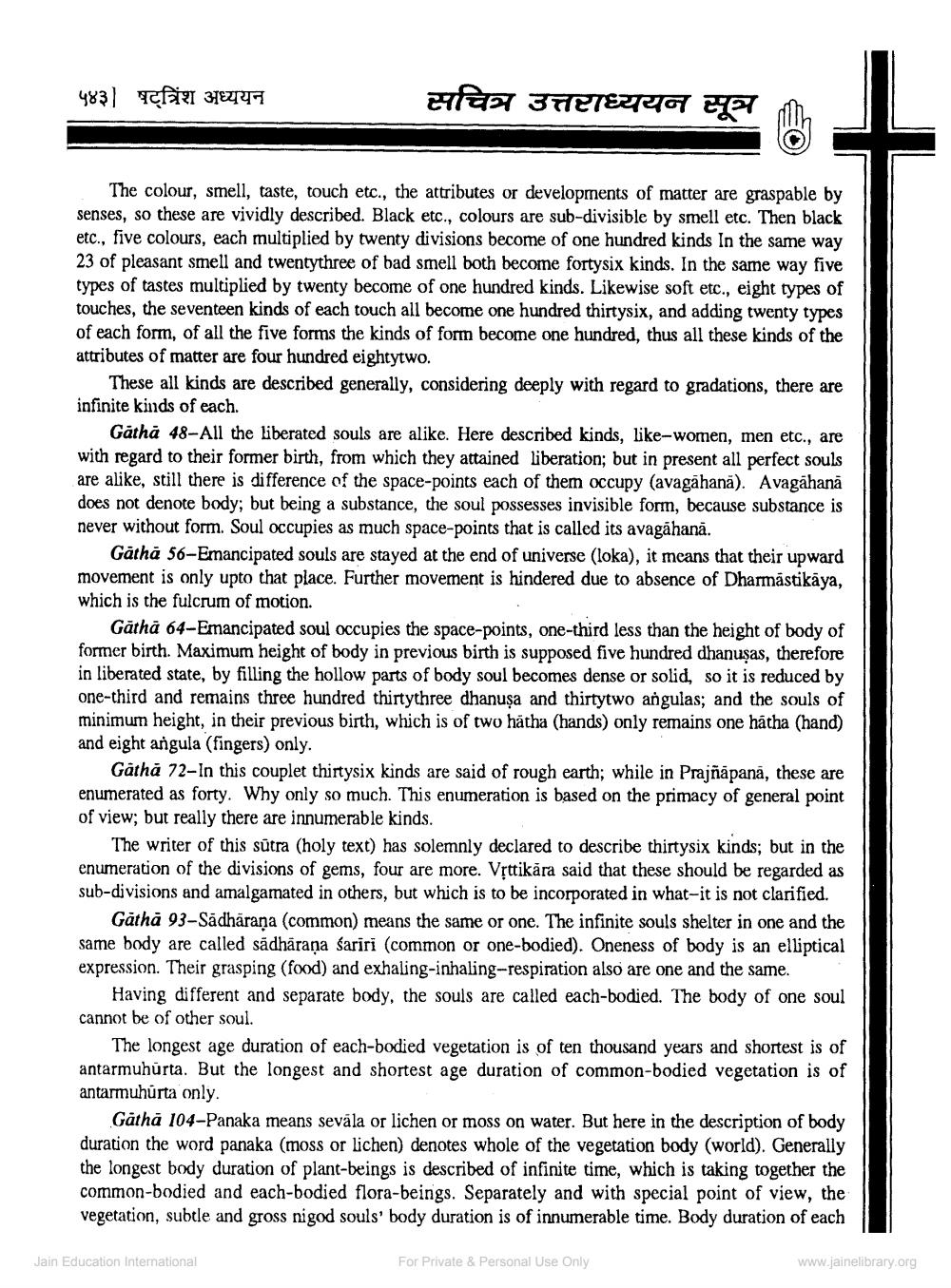________________
५४३ | षट्त्रिंश अध्ययन
]
सचित्र उत्तराध्ययन सूत्र
The colour, smell, taste, touch etc., the attributes or developments of matter are graspable by senses, so these are vividly described. Black etc., colours are sub-divisible by smell etc. Then black etc., five colours, each multiplied by twenty divisions become of one hundred kinds In the same way 23 of pleasant smell and twentythree of bad smell both become fortysix kinds. In the same way five types of tastes multiplied by twenty become of one hundred kinds. Likewise soft etc., eight types of touches, the seventeen kinds of each touch all become one hundred thirtysix, and adding twenty types of each form, of all the five forms the kinds of form become one hundred, thus all these kinds of the attributes of matter are four hundred eightytwo.
These all kinds are described generally, considering deeply with regard to gradations, there are infinite kinds of each.
Gatha 48-All the liberated souls are alike. Here described kinds, like-women, men etc., are with regard to their former birth, from which they attained liberation; but in present all perfect souls are alike, still there is difference of the space-points each of them occupy (avagahaná). Avagahana does not denote body; but being a substance, the soul possesses invisible form, because substance is never without form. Soul occupies as much space-points that is called its avagáhană.
Gatha 56-Emancipated souls are stayed at the end of universe (loka), it means that their upward movement is only upto that place. Further movement is hindered due to absence of Dharmastikäya, which is the fulcrum of motion.
Gatha 64-Emancipated soul occupies the space-points, one-third less than the height of body of former birth. Maximum height of body in previous birth is supposed five hundred dhanusas, therefore in liberated state, by filling the hollow parts of body soul becomes dense or solid, so it is reduced by one-third and remains three hundred thirtythree dhanușa and thirtytwo angulas; and the souls of minimum height, in their previous birth, which is of two hatha (hands) only remains one hátha (hand) and eight angula (fingers) only.
Gatha 72-In this couplet thirtysix kinds are said of rough earth; while in Prajñápana, these are enumerated as forty. Why only so much. This enumeration is based on the primacy of general point of view; but really there are innumerable kinds.
The writer of this sûtra (holy text) has solemnly declared to describe thirtysix kinds; but in the enumeration of the divisions of gems, four are more. Vrttikara said that these should be regarded as sub-divisions and amalgamated in others, but which is to be incorporated in what-it is not clarified.
Gāthā 93-Sadharana (common) means the same or one. The infinite souls shelter in one and the same body are called sådhárana sariri (common or one-bodied). Oneness of body is an elliptical expression. Their grasping (food) and exhaling-inhaling-respiration also are one and the same.
Having different and separate body, the souls are called each-bodied. The body of one soul cannot be of other soul.
The longest age duration of each-bodied vegetation is of ten thousand years and shortest is of antarmuhurta. But the longest and shortest age duration of common-bodied vegetation is of antarmuhurta only.
Gāthā 104-Panaka means sevala or lichen or moss on water. But here in the description of body duration the word panaka (moss or lichen) denotes whole of the vegetation body (world). Generally the longest body duration of plant-beings is described of infinite time, which is taking together the common-bodied and each-bodied flora-beings. Separately and with special point of view, the vegetation, subtle and gross nigod souls' body duration is of innumerable time. Body duration of each
Jain Education International
For Private & Personal Use Only
www.jainelibrary.org




